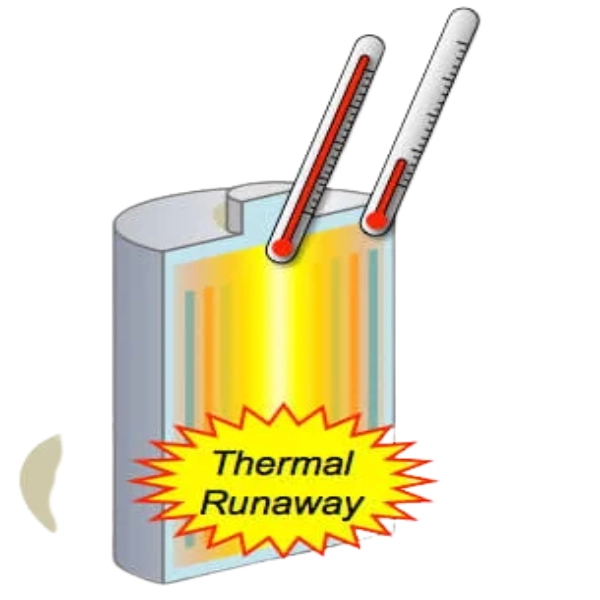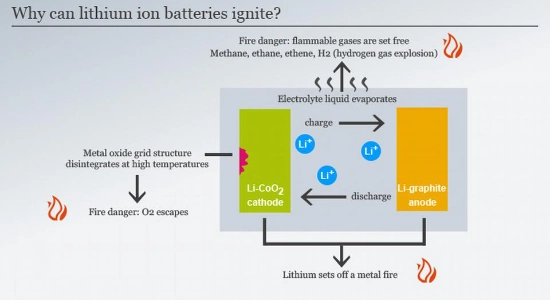Lithium batteries have become an essential power source for various devices, from smartphones to electric vehicles. While they offer numerous advantages, concerns about their safety persist. One common question is whether lithium batteries can catch fire even when unused. In this comprehensive article, we will explore the phenomenon of battery thermal runaway, the reasons behind lithium-ion battery fires, methods to extinguish such fires, and essential tips to prevent battery fires from occurring.

Part 1. Battery thermal runaway
Before delving into the causes of lithium-ion battery fires, it is crucial to understand the concept of battery thermal runaway. Thermal runaway refers to an uncontrolled increase in a battery’s internal temperature, which can lead to a chain reaction resulting in a fire or explosion. This phenomenon can occur due to various factors, including internal short circuits, exposure to external heat sources, physical damage, and overcharging or over-discharging the battery.
Part 2. Why do lithium-ion batteries catch fire?
Lithium-ion batteries are susceptible to catching fire due to several reasons. Let’s examine some of the critical factors:

1. Internal Short Circuits
One primary cause of lithium-ion battery fires is internal short circuits. These occur when the battery’s internal components become damaged or faulty, leading to a rapid discharge of energy and subsequent overheating. If left uncontrolled, this heat can ignite the battery and result in a fire.
2. External Heat Sources
Lithium batteries are sensitive to high temperatures and can catch fire when exposed to external heat sources. When subjected to elevated temperatures, the battery’s electrolyte can break down, triggering thermal runaway. Placing lithium batteries near heat-emitting objects or in direct sunlight can increase fire risk.
3. Physical Damage
Physical damage to lithium batteries can compromise their internal structure, leading to short circuits and potentially causing fires. Punctures, crushing, or severe impact can damage the battery’s protective layers, allowing the internal components to come into contact and create hazardous conditions.
4. Overcharging or Over discharging
Charging lithium batteries beyond their recommended voltage limits or excessively discharging them can result in internal damage. Overcharging can lead to the accumulation of unstable materials on the battery’s electrodes. At the same time, over-discharging can cause the battery’s voltage to drop too low. Both scenarios could ignite the battery and cause a fire.
While the risk of lithium-ion battery fires exists, it is essential to note that such incidents are relatively rare. Battery manufacturers have implemented several safety measures to minimize these risks, including built-in protection circuits and improved designs.
Part 3. How do you put out a lithium-ion battery fire?
In a lithium-ion battery fire, it is crucial to respond swiftly and effectively to prevent the fire from spreading and causing further damage. Here are the recommended steps to safely extinguish a battery fire:
1. Ensure safety
Prioritize personal safety by wearing protective gear like gloves and safety glasses. If the fire is significant or spreading rapidly, evacuate immediately and contact emergency services.
2. Isolate the Fire
If safe, move the burning battery away from flammable materials and surfaces. Using a non-conductive tool or wearing insulated gloves, carefully handle the battery and relocate it to a safe location.
3. Cut Off the Oxygen Supply
Since fires require oxygen to sustain, cutting off the oxygen supply to extinguish the flames is crucial. Place the burning battery inside a fireproof container or submerge it in a bucket of sand or water to suffocate the fire.
4. Use Fire Extinguishing Agents
If available, utilize fire extinguishing agents suitable for electrical fires, such as Class D extinguishers or carbon dioxide (CO2) extinguishers. Follow the extinguisher’s instructions, aim at the base of the fire, and sweep from side to side to extinguish the flames.
5. Monitor and Cool the Battery
After successfully extinguishing the fire, avoid touching the battery immediately, as it may still be hot. Allow the battery to cool down naturally before properly handling or disposing of it.
It is important to remember that in the case of a giant or uncontrollable fire, you should evacuate the area and contact professional firefighters for assistance.
Part 4. How to avoid lithium battery fires?
By following these essential safety measures, you can significantly reduce the likelihood of such incidents:
1. Purchase Quality Batteries
Always invest in high-quality lithium-ion batteries from reputable manufacturers. These batteries undergo rigorous testing and adhere to safety standards, reducing the risk of faults or failures that could lead to fires.
2. Handle with care
Handle lithium batteries with care, avoiding physical damage. Avoid dropping, crushing, or puncturing the batteries, as these actions can compromise their internal structure and increase the risk of fires.
3. Store Properly
Store lithium batteries in a cool and dry place away from direct sunlight and heat sources when not in use. Optimal storage conditions help prevent the batteries from overheating and minimize the fire risk.
4. Avoid Overcharging or Over discharging
Follow the manufacturer’s guidelines regarding charging and discharging lithium batteries. Avoid overcharging them beyond the recommended voltage limits and prevent them from discharging to deficient levels. This practice helps maintain the battery’s stability and reduces the chances of thermal runaway.
5. Use Compatible Chargers
Always use chargers designed explicitly for lithium-ion batteries. Using incompatible or faulty chargers can lead to overcharging, overheating, or other electrical faults that may result in fires.
6. Monitor Charging Process
When charging lithium batteries, never leave them unattended. Regularly check the charging process and remove the battery from the charger once it reaches its recommended charge level. This precaution prevents overcharging and reduces the risk of battery fires.
7. Inspect and Replace Damaged Batteries
Regularly inspect lithium batteries for any signs of damage or swelling. If you notice any abnormalities, such as bulging or leaking batteries, discontinue use immediately and replace them with new ones. Damaged batteries are more prone to internal faults and can pose a significant risk of fires.
Part 5. Conclusion
Lithium batteries can catch fire even when not used, primarily due to internal short circuits, exposure to external heat sources, physical damage, and improper charging practices. However, you can significantly reduce the risk of battery fires by understanding battery thermal runaway, implementing safety measures, and following best practices.
Related Tags:
More Articles

Overview of Deep Cycle Lithium Battery
In this article, we explore the life, voltage, capacity, and charging considerations of deep cycle lithium batteries.
How Long do Lithium Batteries Last?
How long do lithium batteries last? we will explore the factors that influence the lifespan of lithium batteries and provide insights into their longevity.
How to Choose the Best LiFePO4 Battery?
Choose LiFePO4 batteries for superior performance, safety, and versatility in EVs, UPS, and backup power. This guide helps you make informed decisions.
Get 12v Lithium Car Battery As a Power Source for the Ride
Make the right choice for your vehicle's battery needs by installing a 12 volt lithium car battery. You will enjoy maintenance-free longevity with this change.
Everything About A Small Lithium Ion Battery
Discover the features, uses & future potential of a small lithium ion battery. A compact and tiny powerhouse ideal for smartphones, wearables, drones & more.





